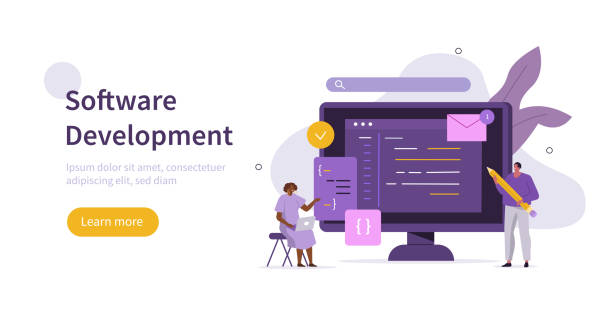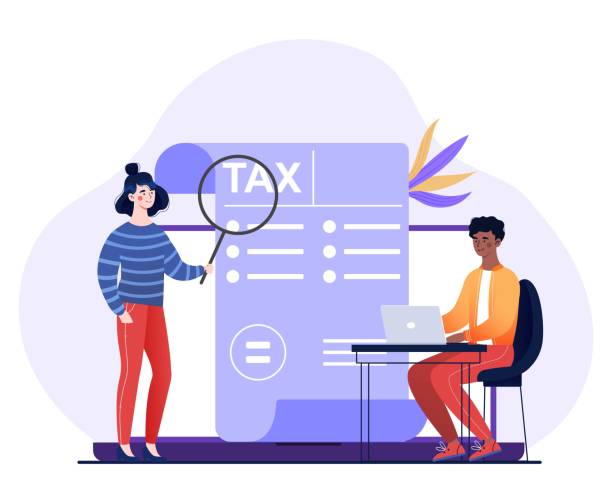Introduction to Secure Website Design and Its Importance

In the information age, where our daily lives are deeply intertwined with the internet, #online_security and #secure_website_design are no longer luxury choices, but vital necessities.
Any business or individual aiming for an effective and sustainable presence in cyberspace must pay special attention to #secure_website_design.
#Protecting_user_data, #sensitive_organizational_information, and #brand_reputation all depend on the methods of implementing #security on the web.
This section (explanatory and educational) helps you gain a deeper understanding of the various aspects of secure website design and its growing importance in today’s digital ecosystem.
A lack of sufficient security measures can lead to catastrophic consequences, from loss of customer trust and heavy legal penalties to irreparable damage to business reputation.
When we talk about secure website design, we don’t just mean installing an SSL certificate; rather, it’s a set of preventive and defensive measures that must be observed throughout all stages of a website’s lifecycle, from planning and coding to deployment and maintenance.
The ultimate goal is to build a digital fortress resistant to various cyberattacks.
The question is: Can a website truly be made 100% secure? The short answer is that absolute security does not exist, but by following best practices and utilizing advanced technologies, the level of vulnerability can be minimized.
In the remainder of this article, we will delve into practical and technical solutions for secure website design, enabling you to build a resilient and trustworthy website.
This topic includes understanding threats, secure coding principles, and proper system management.
Does your current website convert visitors into customers, or does it drive them away? Solve this problem permanently with professional corporate website design by Rasawp!
✅ Establish strong credibility and branding
✅ Attract target customers and increase sales
⚡ Get a free consultation right now!
Common Cyber Threats and Prevention Strategies

To achieve #secure_website_design, we must first become familiar with common #cyber_threats.
Identifying the enemy is the first step in defeating them.
Attacks such as #SQL_Injection, where an attacker gains access to sensitive information by injecting malicious code into the database, or #XSS (Cross-Site Scripting), which allows the execution of malicious scripts in users’ browsers, are among the most common vulnerabilities.
(Analytical and guiding) Additionally, #DDoS (Distributed Denial of Service) attacks, aimed at incapacitating website services, and #Brute_Force attacks, for guessing passwords, are considered other serious threats.
Precise knowledge of these methods and understanding how they work is the cornerstone of any effort towards #secure_web_development.
To prevent these threats in the realm of secure website design, there are several solutions.
Regarding SQL Injection, precise Input Validation and the use of Prepared Statements for database interaction are crucial.
To counter XSS, proper Encoding of all outputs before display in the browser is essential.
Furthermore, using Web Application Firewalls (WAFs), regularly updating systems and software, and implementing strong authentication and authorization mechanisms can significantly enhance website security.
These preventive measures should be continuously applied during the website design and maintenance process to ensure your website remains resilient against emerging attacks.
Did you know that most successful attacks result from known vulnerabilities that are exploited due to lack of updates or incorrect configuration? This is an important question for every web developer.
Basic Principles of Security in Coding and Web Development

(Technical and educational) The foundation of any #secure_website_design lies in the quality and security of its #coding.
#Secure_coding principles refer to a set of practices and patterns that developers must follow to minimize vulnerabilities in web applications.
One of the most important principles is #input_validation; never trust user-supplied input data, and always validate and sanitize it before processing.
This can prevent attacks such as SQL Injection and XSS.
Furthermore, using Prepared Statements for database queries instead of directly concatenating variables is another crucial step towards #database_security.
Another principle is proper error and exception handling.
Displaying generic error messages instead of technical details that could provide useful information to attackers is essential.
Additionally, using secure hashing functions and “salting” for storing passwords, instead of storing them in plain text, is a requirement.
All sensitive information must be #encrypted during transmission and storage.
The table below outlines some of the most common coding mistakes that can harm website security and their corresponding solutions:
| Common Mistake | Description | Security Solution |
|---|---|---|
| Lack of Input Validation | Accepting user inputs without validating their correctness and legitimacy | Thorough validation, input sanitization, and WAF usage |
| Storing Passwords in Plain Text | Storing passwords without hashing or encryption | Using strong hashing functions (e.g., bcrypt) with salt |
| Displaying Detailed Error Information | Exposing technical error details to users | Displaying generic error messages and logging errors securely |
| Using Outdated Components | Failure to update libraries and frameworks | Regular updates and following security news for components |
Furthermore, continuous updating of libraries and frameworks used, and following related security news, is an inseparable part of #secure_web_development.
The Role of Security Protocols in Secure Website Design

One of the most important pillars of #secure_website_design is the use of powerful #security_protocols.
Among these, #HTTPS is recognized as the gold standard for secure web communications.
(Explanatory and technical) HTTPS is essentially the HTTP protocol enhanced with a layer of #SSL/TLS_security.
This protocol ensures that data exchanged between the user and the server is encrypted and safe from unauthorized access.
This is not only crucial for user privacy but also plays an important role in website #SEO; search engines like Google rank HTTPS-enabled websites higher.
Proper HTTPS implementation involves obtaining and installing a valid SSL certificate from a Certificate Authority (CA) and ensuring the server is correctly configured to use it.
But the story of security protocols doesn’t end there.
The #HSTS (HTTP Strict Transport Security) standard adds another layer of security to HTTPS.
HSTS instructs browsers to always connect to your website via HTTPS, without exception, even if the user mistakenly enters the HTTP protocol.
This prevents “Protocol Downgrade Attacks” and ensures that the connection remains encrypted at all times.
Furthermore, regularly reviewing and updating the TLS versions used (e.g., using TLS 1.2 or 1.3 instead of older versions) is essential to maintain the highest level of #website_security.
These protocols are fundamental components in creating a trustworthy environment for users and achieving success in #secure_website_design.
Are you frustrated with your online store’s low conversion rate?
Rasawp, with its professional e-commerce website design, is your definitive solution!
✅ Increase your sales and revenue
✅ Provide an unparalleled user experience for your customers
⚡ Get a free consultation right now!
Identity and Access Management in Secure Websites

(Technical and guiding) #Identity_and_Access_Management (#IAM) is one of the vital aspects of #secure_website_design.
This process involves #Authentication of users to verify their identity and #Authorization to determine their access level to various website resources.
Without a robust IAM system, even the most secure infrastructures can become vulnerable due to flaws in access management.
Utilizing strong authentication methods such as #Two-Factor_Authentication (2FA) or #Multi-Factor_Authentication (MFA) is essential to protect user accounts from unauthorized access.
These mechanisms provide an additional layer of protection, even if a password is compromised.
Additionally, implementing #strong_password_policies and enforcing the use of complex and unique passwords for users is an inseparable part of #website_security.
These policies should include minimum length, a combination of uppercase and lowercase letters, numbers, and special characters.
Furthermore, mechanisms for #account_locking after a certain number of failed login attempts and limiting the number of login requests from a specific IP address (Rate Limiting) should be considered to prevent Brute Force attacks.
The Principle of Least Privilege should also be observed in access design, meaning that each user or system should only have access to the minimum resources required to perform their tasks.
This approach, coupled with continuous monitoring of access logs, helps you maintain a #secure_and_stable_website_design system and minimize the risk of access misuse.
Database Security and Information Storage

The beating heart of any website is its #database, which holds vital information.
Therefore, #database_security is of paramount importance in line with #secure_website_design.
(Technical and educational) Protecting data against unauthorized access, modification, or deletion is an unquestionable priority.
This includes #data_encryption at rest (Data at Rest) and in transit (Data in Transit).
For sensitive data, database encryption can provide an important layer of protection even after a breach.
Proper management of database access is another key aspect.
Never use a “root” or “admin” user account with full access for website interaction with the database.
Instead, create user accounts with the Principle of Least Privilege, granting access only to the tables and operations they require.
Additionally, #Database_Firewalls can help monitor and filter incoming traffic to the database.
Regularly updating the Database Management System (DBMS) such as MySQL, PostgreSQL, or MongoDB, and applying security patches released by the vendor, is crucial.
Finally, performing #regular_and_secure_backups of the database and testing the recovery process is essential to ensure recoverability in the event of security or data incidents.
This comprehensive approach guarantees a #secure_and_sustainable_website_design.
Backup, Recovery, and Emergency Plans

(Guiding and informational) Even with the most meticulous measures in #secure_website_design, no website is immune to cyberattacks, human errors, or system failures.
Therefore, having a #comprehensive_backup_and_disaster_recovery_plan (#Disaster_Recovery) is an indispensable part of a #website_security strategy.
Regular and automated backups of all website data, including the database, configuration files, and uploaded files, is the first step.
These backups should be stored in a secure location separate from the main server, preferably in multiple geographical locations or secure cloud storage.
Having an Incident Response Plan for dealing with security incidents is of great importance.
This plan should include specific steps for identification, containment, eradication, recovery, and lessons learned.
Notably, many companies have faced irreparable financial and reputational losses after a major cyberattack due to the absence of a proper recovery plan. Regular testing of the backup recovery process is essential to ensure that you will be able to restore the website to normal operation when needed.
These tests should include a full system restoration and verification of its proper functioning.
Below, a sample backup checklist is provided:
| Item | Description | Frequency |
|---|---|---|
| Database Backup | All tables and data | Daily/Hourly |
| Website Files Backup | Code, images, configuration files | Daily/Weekly |
| Store Backups in Secure Locations | Cloud storage, external disks | After each backup |
| Test Recovery Process | Simulate full system restoration | Monthly/Quarterly |
These measures ensure that even in the worst-case scenarios, #business_continuity is maintained, and damages are minimized.
This is one of the fundamental principles of #secure_website_design.
Penetration Testing and Vulnerability Assessment

After implementing all measures in #secure_website_design, how can one ensure their effectiveness? (Analytical and technical) The answer lies in conducting #Penetration_Testing and #Vulnerability_Assessment.
Vulnerability assessment means identifying and enumerating potential security weaknesses in a system or network, while penetration testing is a controlled simulation of a real attack conducted by security specialists (with authorization) to discover exploitable vulnerabilities.
These processes allow you to identify and fix vulnerabilities before real attackers discover and exploit them.
Regularly performing vulnerability scans using automated tools can help quickly identify known weaknesses.
However, to discover more complex and application-specific vulnerabilities, such as logical flaws or multi-stage attack chains, #manual_penetration_testing by an Ethical Hacker is essential.
These tests should be conducted after any major change in code or infrastructure, as well as periodically (e.g., annually).
The reports resulting from these tests provide valuable insights for continuous improvement of your #website_security.
Not investing in this area can be significantly more costly than compensating for damages from a successful attack.
This is one of the most important aspects in maintaining and enhancing #secure_website_design.
Did you know that 94% of a first impression of a company is related to its website design?
Rasawp, by offering professional corporate website design services, helps you create the best first impression.
✅ Create a professional and trustworthy image for your brand
✅ Easier attraction of potential customers and improvement of online standing
⚡ Get a free corporate website design consultation!
New Challenges in Secure Website Design and Its Future

The world of #cybersecurity is constantly evolving, and with the emergence of new technologies, new challenges also arise.
(Analytical and thought-provoking content) In the realm of #secure_website_design, topics such as the #Internet_of_Things (IoT) and its integration with websites have created unique security challenges.
Did you know that IoT devices often have known security vulnerabilities that can act as a gateway for attacks on connected websites? This phenomenon adds new dimensions to the concept of #secure_web_design and requires more comprehensive approaches.
Furthermore, the growth of #Artificial_Intelligence (AI) and #Machine_Learning (ML) has brought both opportunities and threats to website security.
On one hand, AI can assist in identifying attack patterns and detecting complex threats; on the other hand, attackers can also use AI to automate and smarten their attacks.
Protecting data privacy in an era where vast amounts of information are collected and processed by websites is also a major challenge.
Given stricter data protection regulations like #GDPR and #CCPA, #secure_website_design must incorporate “Privacy by Design” approaches.
The future of secure website design not only requires continuous updates of technologies and knowledge but also a proactive and flexible approach to counter unknown and more complex threats.
These developments indicate that the focus on #secure_web_development should never cease.
Conclusion and Final Recommendations for a Secure Website

At the end of this comprehensive journey into the world of #secure_website_design, it must be emphasized that #website_security is an ongoing process, not a final destination.
(Explanatory and guiding) Given the constant dynamism of cyber threats and their increasing complexity, websites must be continuously reviewed, updated, and protected.
All the topics examined in this article, from secure coding principles and the use of encryption protocols to proper identity and access management and disaster recovery planning, are all pieces of a larger puzzle called #secure_web_design.
Neglecting any of these components can break the security chain and make your website vulnerable to attacks.
Our final recommendation is to always adopt a comprehensive and layered approach (Defense in Depth) for your website’s security.
This means implementing multiple layers of defense, so that if one layer fails, subsequent layers can protect the system.
From continuous training of the development team on secure coding best practices to collaborating with cybersecurity specialists for penetration testing, all are essential for maintaining a #secure_website_design.
Remember that user #trust is your most valuable asset in the digital space, and this trust is only gained by providing a secure and reliable user experience.
By following these guidelines, you can take a significant step towards building a secure and resilient website.
Frequently Asked Questions
| Question | Answer |
|---|---|
| What is secure website design? | Secure website design is the process of building websites with security principles in mind to withstand cyberattacks and protect user and business information. |
| Why is secure website design highly important? | To prevent unauthorized data access, sensitive information leaks, malware attacks, loss of user trust, damage to business reputation, and legal consequences resulting from data breaches. |
| What are the most common website vulnerabilities? | SQL Injection, Cross-Site Scripting (XSS), Cross-Site Request Forgery (CSRF), broken authentication and session management, and sensitive data exposure. |
| How can SQL Injection attacks be prevented? | Using Prepared Statements with parameterized queries, input validation, and restricting database access. |
| What are the methods to counter XSS (Cross-Site Scripting) attacks? | User input validation, output encoding before displaying in HTML, and using Content Security Policy (CSP). |
| What is the role of HTTPS in website security? | HTTPS encrypts the communication between the user’s browser and the website server using an SSL/TLS certificate, preventing eavesdropping, tampering, or forging of data. |
| What are the best practices for managing user passwords? | Enforcing strong passwords (a combination of letters, numbers, and symbols), hashing passwords instead of direct storage (with strong algorithms like bcrypt), and enabling Two-Factor Authentication (2FA). |
| What is the importance of user Input Validation? | Input validation prevents malicious or unexpected data from entering the system, which could lead to vulnerabilities like SQL Injection or XSS. |
| What impact do regular security reviews and audits have on site security? | These reviews help identify vulnerabilities and security weaknesses early, enabling their remediation before they can be exploited. |
| What is the use of a Web Application Firewall (WAF) in secure website design? | A WAF acts as a protective layer between the user and the website, analyzing incoming traffic and identifying and blocking common web attacks such as SQL Injection and XSS. |
And other services of Rasa Web Advertising Agency in the field of advertising
Smart Sales Automation: An innovative service to increase click-through rates through marketing automation.
Smart UI/UX: An innovative service for improved campaign management through custom programming.
Smart Social Media: Revolutionize campaign management with the help of optimizing key pages.
Smart SEO: A fast and efficient solution for online growth, focusing on precise audience targeting.
Smart Digital Branding: A specialized service for growing customer acquisition based on precise audience targeting.
And over a hundred other services in the field of internet advertising, advertising consultation, and organizational solutions
Internet Advertising | Advertising Strategy | Advertorial
Resources
Web Security Resources Website Design Guide Security in the Digital World Secure Web Articles
? To reach the peak of success in the digital world, Rasawp Afarin is by your side with professional responsive website design and digital marketing services.
📍 Tehran, Mirdamad Street, next to Bank Markazi, Kazeroun Jonoubi Alley, Ramin Alley No. 6

